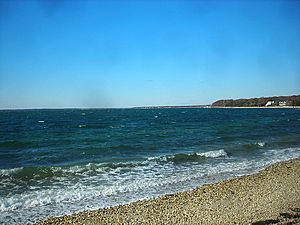Peconic Bay facts for kids
Quick facts for kids Great Peconic Bay |
|
|---|---|
 |
|
| Location | Suffolk County, New York |
| Coordinates | 40°57′49″N 072°28′0″W / 40.96361°N 72.46667°W |
| Primary inflows | North Atlantic |
| Primary outflows | little Peconic bay |
| Basin countries | United States |
| Max. depth | 80 ft (24 m) |
| Surface elevation | 10 ft (3.0 m) |
The Peconic Bay is a large water area in New York, located on Long Island. It's actually made up of two main parts: the Great Peconic Bay and the Little Peconic Bay. These bays are found between the "North Fork" and "South Fork" areas of Long Island. They are separated from another bay called Gardiners Bay by Shelter Island.
Contents
Discover the Peconic Bay
The Peconic Bay is divided into two main sections by Robins Island. On the west side, you'll find the Great Peconic Bay. The very western end of this bay is also known as Flanders Bay. To the east of Robins Island is the Little Peconic Bay.
How Deep Are the Peconic Bays?
The Great Peconic Bay is quite shallow, usually less than 30 feet (9.1 m) deep. However, the Little Peconic Bay is much deeper, reaching depths of over 80 feet (24 m). Even though they have different depths, people often call both of them "the Peconics."
Connecting the Waters
The Shinnecock Canal is a waterway that connects the Great Peconic Bay to Shinnecock Bay. This canal helps boats travel between these different water bodies.
A Special Water System
The Peconics are a unique type of water system called a tidal estuary. This means they are where fresh water from rivers mixes with salty ocean water. The Peconic River flows into the western end of the system, bringing in fresh water.
What is Brackish Water?
Other smaller creeks, like Meeting House Creek and James Creek, also flow into the Peconics. These creeks bring in water that is less salty than the ocean. This mix creates "brackish water," which is a little bit salty but not as salty as the sea.
Home for Marine Life
This special brackish water is perfect for many types of sea creatures. For a long time, the Peconic Bay was full of clams, oysters, and bay scallops. These shellfish need brackish water to grow. They also rely on tiny plants and animals called phyto and zooplankton, which are the first step in the bay's food chain. Efforts have been made to help these shellfish populations grow again.
Fishing and Fun in the Peconics
The Peconic Bay is a popular spot for fishing and other water activities. While some fish, like the winter flounder, are not as common as they used to be, you can still find many others.
What Can You Catch?
Anglers often catch fluke (also known as summer flounder), bluefish, porgy (scup), and sometimes northern weakfish. People use bait like clams, squid, and spearing to catch them. In late summer, young bluefish, called snappers, are fun for kids to catch.
Crabbing and Boating
August is a great time for blue claw crabbing in the inlets and creeks. Recent years have seen many crabs caught. The Peconic Bay is also a wonderful place for boating. Its calm waters in summer and steady winds in the late afternoon make it perfect for sailing. It's a favorite vacation spot for people from New York and other East Coast areas.
A Bit of History: Peconic County
The Peconic Bay even gave its name to an idea for a new county called Peconic County, New York. This proposed county would have included the eastern part of Suffolk County, which surrounds the bay. The idea was to split Suffolk County because the western part is more like a suburb, while the eastern part is more rural. This idea has been discussed for a long time but hasn't been actively pursued since 1998.


